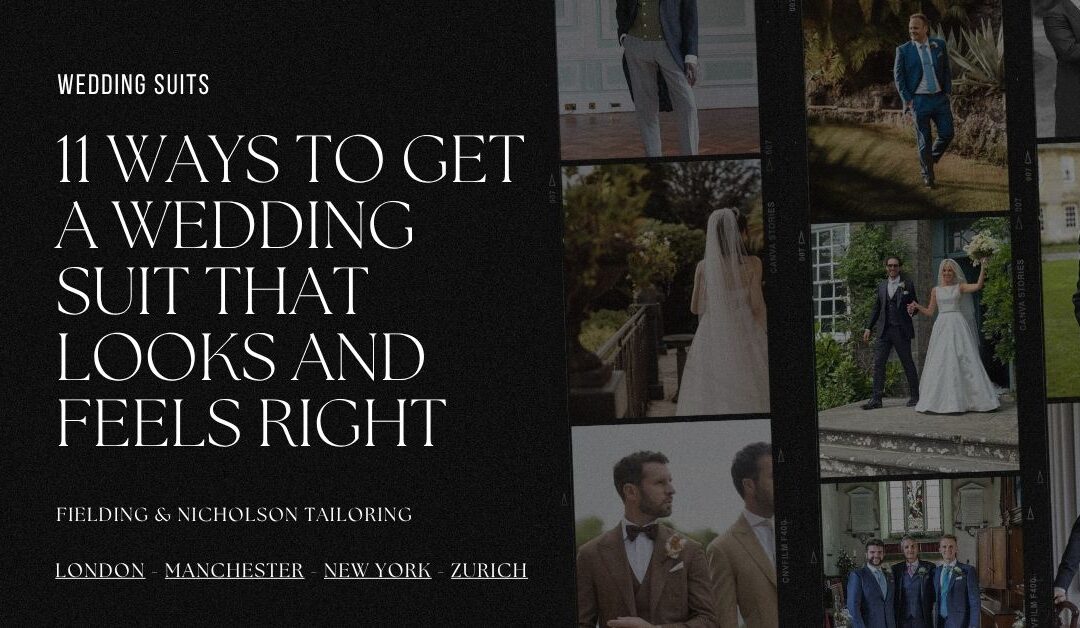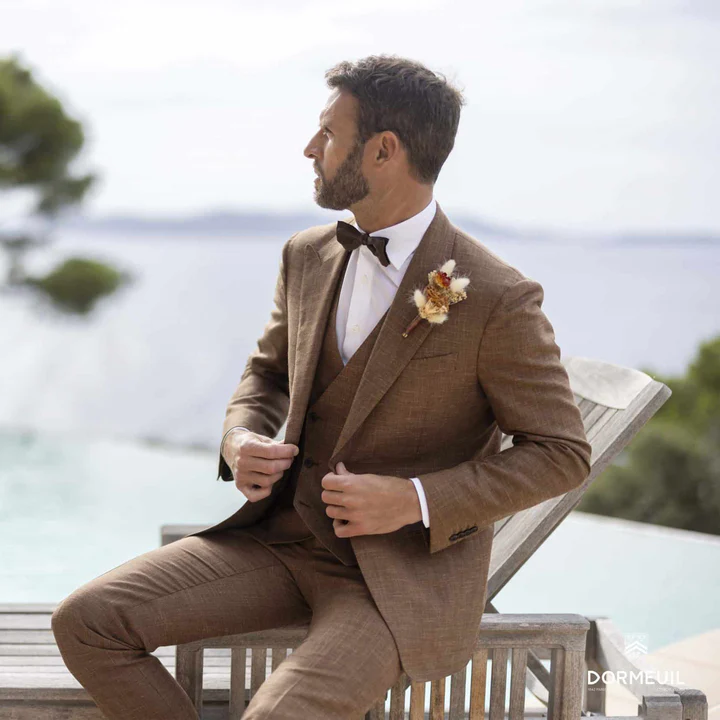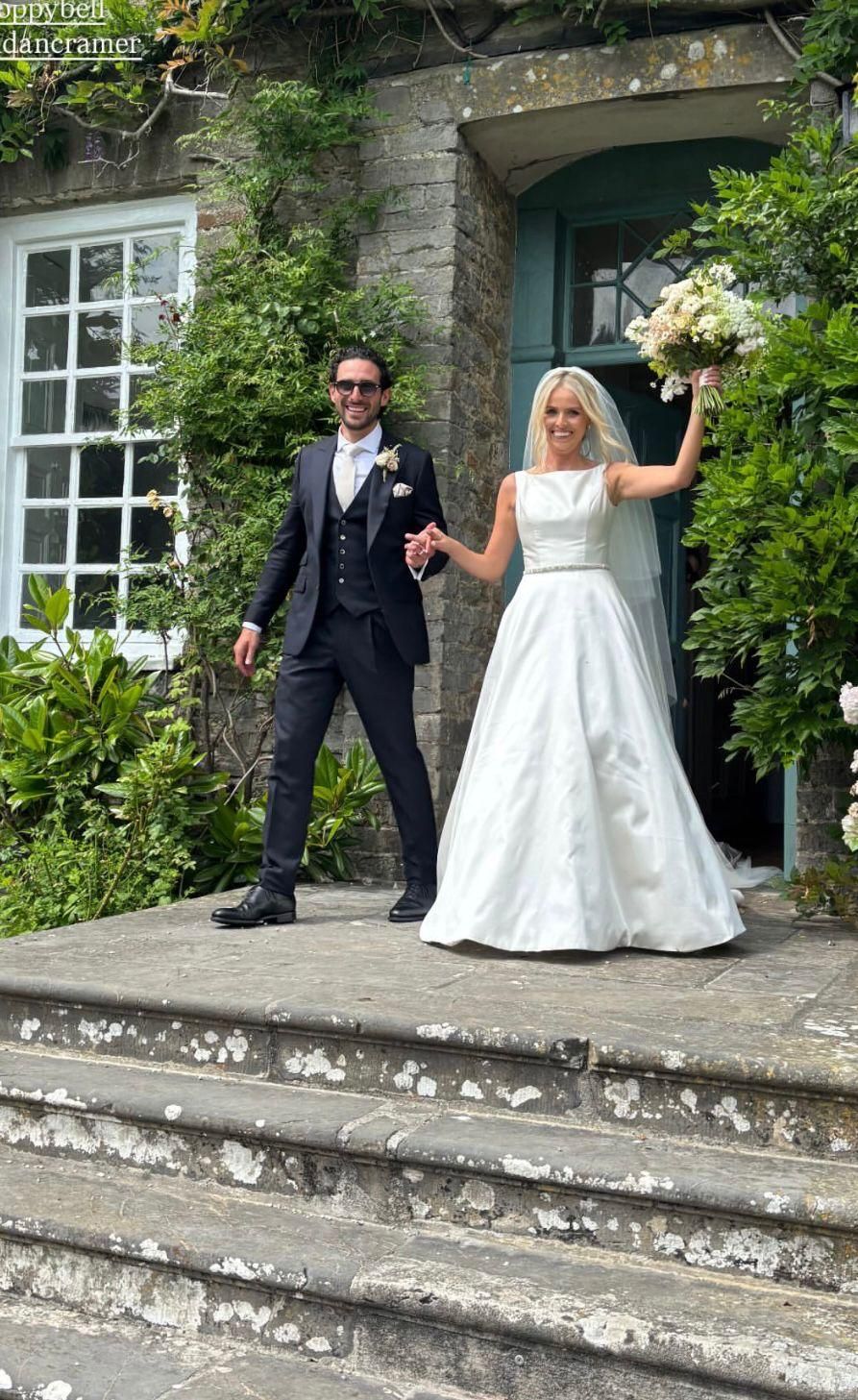What is the correct wedding suit fit and why do measurements matter?
The right wedding suit fit changes everything. It influences your confidence, posture and the way you carry yourself throughout one of the most important days of your life. From the first look to the last dance, a properly fitted suit enhances your movement, showcases your style and becomes part of the memories captured in every photograph. Getting those wedding suit measurements right is really important and that is whether you’re the groom, part of the wedding party or dressing to celebrate love in your own way.
Here's What We Have Covered In This Article
1. Why the Right Fit Changes Everything
A well fitting suit shapes how you feel and how others see you. The right silhouette helps you stand taller, walk with confidence and stay fully in the moment. When the shoulder seam lines up neatly, the trouser hem sits cleanly and the lapel rests flat, everything flows. A well-cut suit shows care and thought, and that comes across in every detail on your wedding day.
Whether you are getting married in a stately home, a local registry office or a quiet garden, your suit should fit your surroundings. A proper fit means you can move freely and comfortably throughout the ceremony, reception and beyond. Body language becomes more open, and that ease translates directly into the energy of the event. A perfect fit doesn’t just make the groom look sharp. It lifts the feel of the whole celebration.
Body Language and Silhouette
Your suit affects how you move and how you are seen. A gently tapered jacket waist shapes the torso, while trousers that sit correctly help create a taller, cleaner silhouette. Cuff length, lapel width and collar position all matter. Together, these details express style without saying a word.
Ceremony Style and Fit Choice
Your wedding location and theme should guide the structure of your suit. Black tie calls for a firm shoulder line and structured cut. A more relaxed or outdoor setting might work better with soft tailoring and breathable fabric. Think about lapel width, jacket length and cloth weight in relation to the season and setting.
Pro Tip 1: Photograph Yourself in the Suit from All Angles What you see in the mirror isn’t always what shows up in photos. Use front, side and back images to spot proportion issues you might miss
2. The 6 Fit Zones Every Groom Should Know
Every on point wedding suit depends on six key areas. If these parts are right, the rest usually falls into place. When each part supports the others, your suit feels natural and stays sharp all day.
Shoulders
The jacket’s shoulder seam must end exactly where your shoulder ends. If it hangs over, the jacket looks too big and loses shape. If it falls short, you will see puckering near the sleeve. Shoulder balance is a key reference point for tailors, especially when drafting patterns for made to measure suits.
Chest and Waist
Your jacket should lie flat against your chest, without bulging or straining. A soft taper towards the waist creates a clean V shape, also known as waist suppression. When buttoned, the fabric should lie smooth. If it wrinkles in an X shape, the fit is too tight. Good tailoring sculpts without restricting.
Jacket Sleeve and Cuff
Jacket sleeves should end just above the wrist bone. This allows a small portion of shirt cuff, about one quarter inch, to show. It gives a polished finish and lets you show off any monogram or cufflinks. The sleeve pitch, or angle of the sleeve from the shoulder, affects how the sleeve hangs when your arms are relaxed.
Trouser Seat and Rise
Trousers should skim the seat without pulling or sagging. Horizontal lines across the backside usually mean the fit is too tight. The rise, which refers to the distance from the crotch to the waistband, should be proportionate to your body and match the overall cut. Most modern fits sit just below the natural waist.
Trouser Break
A small break at the hem means your trousers gently touch the top of your shoes. This is clean and traditional. A sharp, no break finish suits a slimmer style. If the fabric pools at the ankle, the trousers are too long and should be hemmed to restore the line.
Jacket Length
The jacket should cover your seat and fall to about the middle of your hand when arms are relaxed. A too-short jacket can look unbalanced, while too long can appear oversized. Always check the side profile to confirm the front and back drop match.
Lapel and Collar Fit
Lapel width should match both your frame and tie. Slim lapels work well on narrow builds while wider lapels add presence for broader frames. The collar should hug the shirt smoothly. If you notice a gap between the collar and the back of the neck, your jacket needs a collar roll adjustment.
3. Move With Confidence: Fit That Works All Day
Your wedding day is not a photoshoot. You will be walking, hugging, laughing and dancing. Your suit needs to support all that. A good fit is not just how it looks but how it moves with you.
Real-Life Fit Checks
When trying on your suit, move around naturally. Sit down, walk across the room, raise your arms and try a gentle spin or two. The fabric should not strain across the back or chest, sleeves should stay close without riding up, and the trousers should move smoothly. A fitting session is not complete without these movement checks.
Range of Motion
Sleeve pitch and armhole height affect how freely your arms move. Shoulder slope impacts how the jacket rests when your posture changes. These technical details are not obvious at first glance but make all the difference by the time you hit the dance floor or lift your partner for a hug.
Suit Comfort from Start to Finish
Look for ergonomic tailoring that supports your movements throughout the day. This includes subtle adjustments like extra room in the back panel or curved seams through the waist. Trousers with a small allowance in the hip area improve hip clearance and ease of sitting. If you can forget about your clothes and focus on the moment, that means the fit is right.
If you’re unsure how to test these areas properly, speak with a local tailor or use a comprehensive wedding suit fitting guide from a trusted source such as Moss Bros for extra support.
Pro Tip 2:Always Do a ‘Sit and Stretch’ Test During Fittings If you can sit, stretch and move without adjusting your jacket or trousers, you’ve found a winning fit.
Need Help Styling Your Groom’s Party?
Book a one-on-one consultation with our wedding style expert and make your wedding day look as good as it feels.
4. Common Suit Fit Mistakes and How to Avoid Them
Even well made wedding suits can fall short if the fit is off. Here are the issues to spot early and fix before your big day.
Jacket Pulls in the Middle
This is known as the X pull. When you button your jacket and see fabric pulling into an X shape around the waist, that usually means the chest or waist is too tight. An adjustment or letting out the seams can resolve this.
Gap Between Shirt and Jacket Collar
If the collar of your jacket lifts away from your shirt collar, especially at the back of the neck, the jacket is not sitting properly on your shoulders. A collar roll adjustment can often fix this. Tailors use this technique to reshape the back of the jacket for a cleaner lay.
Twisting Sleeves
Twisted or crumpled sleeves are usually caused by incorrect sleeve pitch. This means the angle the sleeve is attached does not match your natural arm position. If you see this when your arms are relaxed, ask for a sleeve rotation or repitch.
Pooling Trousers
Trousers that bunch heavily at the ankles create a sloppy look and ruin clean lines. The fix is usually a simple one — a hem adjustment based on your shoe height and preferred break.
Overtight Seat and Drag Lines
Lines across the back of your trousers suggest the seat is too tight. This can be solved with a bit more room in the seat or thigh. Smooth fabric over the hips and backside is a good indicator that the fit is right.
Shirt Hidden Under Jacket
Your jacket should allow your shirt cuff to peek through slightly. If the jacket covers the cuff completely or causes the shirt to bunch at the wrist, the sleeve is likely too long or the armhole too low. A small tailoring adjustment brings everything back into line.
5. A Suit That Fits Everyone: Inclusive Fit and Gender Expression
Everyone deserves a suit that feels like them. Whether you are a butch bride, a trans groom, non binary or simply prefer a more gender neutral style, fit matters. Comfort, confidence and identity all play a part in how your suit should come together.
Gender Affirming Tailoring
Tailors can adapt suit patterns to fit a wide range of bodies and expressions. This might mean reducing bust shaping, adding extra room through the hips or softening the shoulder line. Androgynous cuts, boxy shapes or strong waists can all be worked into a design that fits your identity.
Inclusive Fittings and Terminology
Choose tailors who welcome all clients and use affirming language. Many now offer gender inclusive fittings and have experience working with LGBTQ plus clients. Tailoring terms like bust tapering, hip contouring and shoulder balance are just technical language. How you want to look and feel guides the rest.
Clothing That Supports Confidence
Whether you want a structured Savile Row inspired suit or a soft draped style with no padding, the goal is always to make you feel good. Fit should support posture and silhouette without pushing anyone into traditional shapes they don’t want. Personal style and identity should shape the final look.
Don’t Guess the Dress Code
Access our full formalwear checklist to avoid mismatches and last-minute panic.
6. How Fabric Choice Affects Fit and Feel
Fabric choices can completely change how a suit behaves. The way a cloth moves, drapes and holds shape can shift both the style and the comfort level of your wedding suit.
Different Fabric Types
Wool is the most common suit fabric. It offers structure, wrinkle resistance and breathability. Wool blends add stretch which supports mobility and comfort. Linen is light and breathable, ideal for summer weddings but tends to wrinkle easily. Cotton blends can be a good middle ground offering softness and airflow without as much creasing.
Fabric Weight and Drape
Lightweight fabrics work best for warmer weather and softer silhouettes. Heavier cloth holds shape better and suits more traditional styles. Drape refers to how fabric hangs from the body. A crisp worsted wool will drape cleanly. A looser weave will follow curves more softly and suit relaxed fits.
Matching Fabric to Ceremony Style
Beach or destination weddings call for linen or cotton. A winter wedding in a formal venue suits structured wool in heavier weights. Ask your tailor for advice based on location, weather and desired shape. Remember that fabric affects not just temperature and weight but how clean or casual your whole look feels.
- 7. The Drape Suit: A Classic Fit That’s Back in Style
The drape suit has its roots in classic British tailoring and is back on the radar for modern weddings. This style adds fullness in the chest and upper sleeve with a gentle taper at the waist. It’s flattering, comfortable and carries a timeless confidence.
The Drape Cut Explained
Originating from London’s Savile Row, the drape cut uses extended shoulder lines, soft chest canvas and slightly fuller sleeves. It creates the illusion of broader shoulders and a more athletic frame. This cut is known for its movement and ease while still looking refined.
Why Grooms Are Choosing It Again
Grooms are looking for suits that feel as good as they look. The drape suit provides structure and elegance without feeling restrictive. For anyone wanting a vintage inspired silhouette with a strong presence, this style fits the bill.
Structured Style with a Soft Touch
The classic V shape created by the drape cut works well on most body types. Its wider lapels, shaped waist and fuller chest give presence without bulk. It also suits heavier cloths which can be useful for weddings held in cooler seasons.
8. How to Check If Your Suit Looks Right
Sometimes the easiest way to tell if a suit fits well is simply to look. These visual markers help you judge if everything is balanced and proportional. Whether you are standing in front of a mirror or reviewing photos, knowing what to check makes spotting issues quicker.
Shoulder Seam and Jacket Back
Check that the shoulder seam lines up with your natural shoulder. From the back, the jacket should lie flat without ripples or horizontal creases. If it pulls across the back, it might be too tight. If it drapes with excess fabric, it could be too loose.
Collar and Lapel Line
The collar should sit neatly against your shirt with no gaps or folding at the back. Lapels should follow the line of your chest. A gaping or bowing lapel can signal poor chest fit or collar roll issues.
Sleeve and Shirt Cuff Visibility
About one quarter inch of your shirt cuff should be visible beyond the jacket sleeve. This small detail shows attention to proportion. If no cuff shows, the sleeve is too long or the jacket armhole is too low.
Jacket Length and Trouser Line
The jacket should cover the seat and fall just around the midpoint of your hand when relaxed. Trousers should hang cleanly from the seat, with a single break at the hem. Too much break or bunching can interrupt the clean line of the leg.
Use Photos as a Fit Tool
Taking photos from the front, side and back can reveal issues you may not notice in a mirror. Look for symmetry, smoothness and alignment. Check if your lapels sit evenly, if the hem is straight and if the jacket vents lie flat.
9. Make It Yours: Monograms, Lining and Unique Details
Your wedding suit can carry emotional value and personality through small, meaningful touches. Personalised elements not only make the suit yours but also add to the story of the day.
Embroidery and Monograms
Adding your initials inside the jacket or under the collar is a popular choice. You can also stitch a small date or message into the lining. These details stay mostly hidden but become keepsakes in their own right.
Contrast Lining and Stitching
Choosing a colourful or patterned lining lets your personality shine. You might go with a fabric that nods to your heritage, shared memories or wedding theme. Contrast stitching, particularly on buttonholes or the lapel pinhole, also adds a unique touch.
Signature Buttons and Finishing Touches
Some grooms opt for custom buttons, whether engraved or selected to match the wedding colours. You could also add a lapel pin, special cufflinks or a personalised label. These are small details that make a big difference in photos and memories.
Inside Messages and Hidden Symbols
Tailors often include internal pockets where you can add a private note or sewn-in memento. Whether it’s a tribute to family, a good luck token or a shared quote, it adds personal significance to the garment.
For more inspiration on making your suit feel personal, read these ideas from Suit Direct.
Planning a Wedding? Let’s Make It Easy
From suits to schedules, our experts simplify it all. Tailored planning support for the modern couple.
10. Renting or Buying? Getting the Best Fit Either Way
Not everyone wants to purchase a suit outright. Renting can be a practical choice, especially for groomsmen or less formal weddings. That said, the goal should always be the same — achieving a fit that looks clean and feels right.
What to Look For in a Rental Suit
Start with the basics. Shoulder fit, jacket length and trouser seat are the areas where most rental issues appear. Choose a brand that offers modern cuts and updated sizing. Ask about slim, modern or classic fit options so you can select the best silhouette for your build.
Can You Alter a Rental Suit?
Most rental suits allow for basic alterations like trouser hem length or sleeve adjustment. However, more structural changes such as waist suppression or collar corrections are usually not permitted. Focus on finding the closest match, then fine-tune where possible.
Remote Sizing and Fit Kits
Many rental companies offer online measuring tools or home try-on kits. Use these to get a proper fit before collection day. If possible, book an in-person fitting appointment to double-check proportions and comfort.
Groom and Groomsmen Coordination
If you’re renting suits for the whole party, choose a provider that allows group bookings and consistency across sizes. Request samples early and review photos together. Uniformity in fit and colour keeps everyone looking sharp on the day.
11. Your Wedding Suit Fitting Timeline
Planning your fittings well ahead of the wedding avoids stress and gives time for changes. A clear timeline means you can get the suit you want with the fit you need.
When Should You Start the Suit Process?
Begin shopping for your wedding suit around six months before the date. This gives you time to explore off the rack, made to measure or bespoke options. It also allows for fittings, fabric selection and any delays.
How Many Fittings Do You Need?
For most grooms, two to three fittings are ideal. The first is for choosing the style and taking measurements. The second fitting checks the alterations and ensures the suit fits as expected. A third fitting may be needed if your body shape changes or for last minute adjustments.
Final Adjustments Closer to the Day
Book your final fitting around three to four weeks before the wedding. This allows for any body changes and keeps the suit fresh. If you are travelling or attending events beforehand, make sure to factor that into your fitting schedule.
Group Fittings for Groomsmen
If you have a wedding party, organise fittings together where possible. Coordinating suits for multiple people takes extra time, so start this process as early as you can. Make sure everyone has their measurements ready and schedule time buffers between fittings.
Considerations for Weight Changes
If you expect to gain or lose weight before the wedding, speak to your tailor early. Suits can be adjusted slightly, but there are limits. Built-in allowances, especially in the seams, help with small changes, but try to stabilise your size by the final fitting.
Final Thoughts: Confidence Begins With Fit
How should a wedding suit fit around the waist?
The jacket should gently taper at the waist to follow your shape without pulling. This is known as waist suppression. It helps create a balanced silhouette and gives the suit structure without feeling tight.
Can I wear a slim fit suit if I have a broad build?
Yes, but with some care. Choose a version of slim fit that allows room in the chest and shoulders. Focus on clean lines without excessive tapering. A modern fit might also suit you if slim feels too narrow.
What fabrics are best for summer weddings?
Linen, cotton and lightweight wool are ideal for summer weddings. Linen is the most breathable but wrinkles more easily. Cotton blends offer comfort and airflow. Lightweight wool gives shape with some natural stretch.
Do I need to wear a belt with my suit trousers?
Only if your trousers have belt loops. Many wedding suits use side adjusters or braces instead for a cleaner look. A belt can break the line of your silhouette, so it’s best to follow the suit’s built-in support.
Should I rent or buy my wedding suit?
Buying offers a perfect fit and more personal details, especially for the groom. Renting is more cost effective and convenient for groomsmen or if you don’t plan to wear the suit again. Fit should always be the deciding factor.





